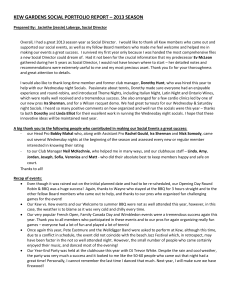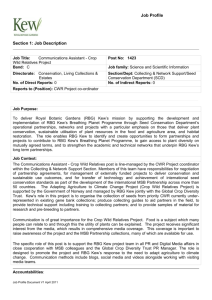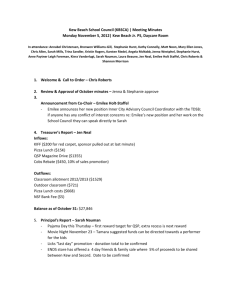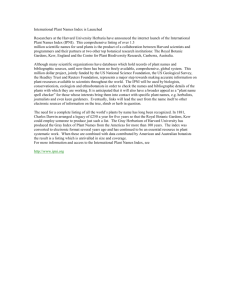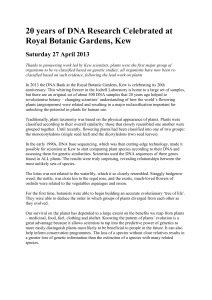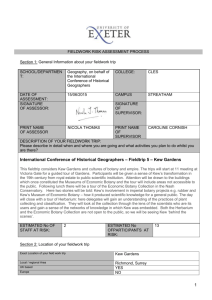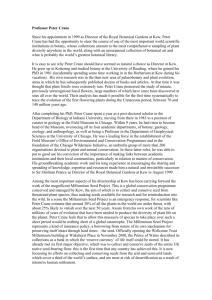The United Kingdom Cross-Departmental Team
advertisement
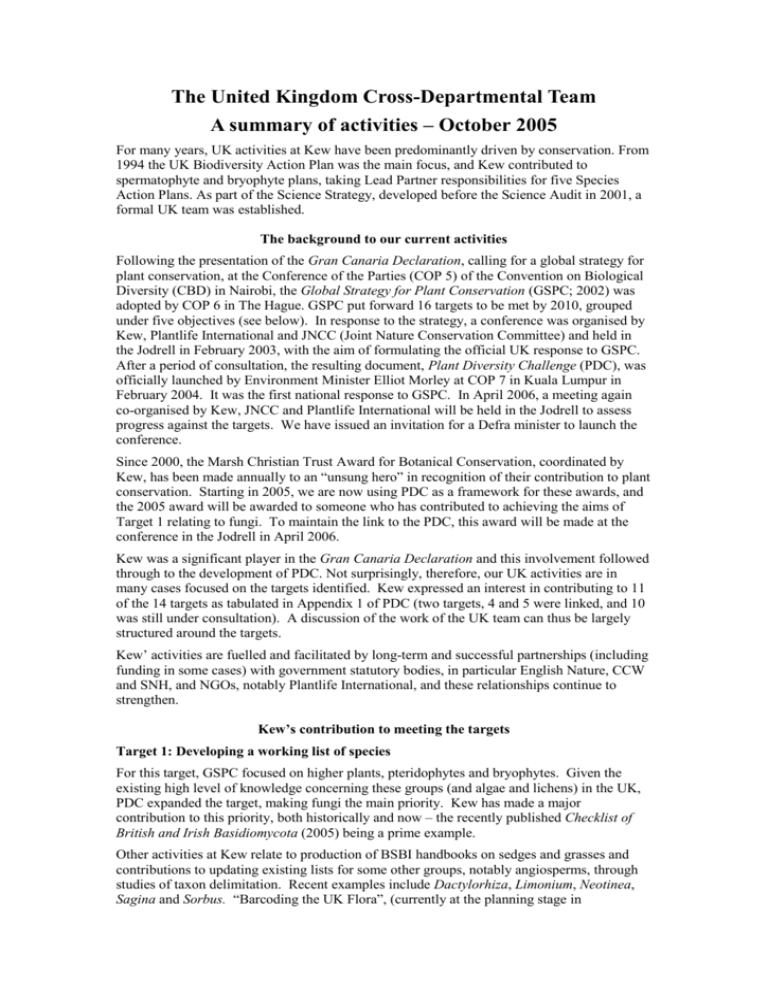
The United Kingdom Cross-Departmental Team A summary of activities – October 2005 For many years, UK activities at Kew have been predominantly driven by conservation. From 1994 the UK Biodiversity Action Plan was the main focus, and Kew contributed to spermatophyte and bryophyte plans, taking Lead Partner responsibilities for five Species Action Plans. As part of the Science Strategy, developed before the Science Audit in 2001, a formal UK team was established. The background to our current activities Following the presentation of the Gran Canaria Declaration, calling for a global strategy for plant conservation, at the Conference of the Parties (COP 5) of the Convention on Biological Diversity (CBD) in Nairobi, the Global Strategy for Plant Conservation (GSPC; 2002) was adopted by COP 6 in The Hague. GSPC put forward 16 targets to be met by 2010, grouped under five objectives (see below). In response to the strategy, a conference was organised by Kew, Plantlife International and JNCC (Joint Nature Conservation Committee) and held in the Jodrell in February 2003, with the aim of formulating the official UK response to GSPC. After a period of consultation, the resulting document, Plant Diversity Challenge (PDC), was officially launched by Environment Minister Elliot Morley at COP 7 in Kuala Lumpur in February 2004. It was the first national response to GSPC. In April 2006, a meeting again co-organised by Kew, JNCC and Plantlife International will be held in the Jodrell to assess progress against the targets. We have issued an invitation for a Defra minister to launch the conference. Since 2000, the Marsh Christian Trust Award for Botanical Conservation, coordinated by Kew, has been made annually to an “unsung hero” in recognition of their contribution to plant conservation. Starting in 2005, we are now using PDC as a framework for these awards, and the 2005 award will be awarded to someone who has contributed to achieving the aims of Target 1 relating to fungi. To maintain the link to the PDC, this award will be made at the conference in the Jodrell in April 2006. Kew was a significant player in the Gran Canaria Declaration and this involvement followed through to the development of PDC. Not surprisingly, therefore, our UK activities are in many cases focused on the targets identified. Kew expressed an interest in contributing to 11 of the 14 targets as tabulated in Appendix 1 of PDC (two targets, 4 and 5 were linked, and 10 was still under consultation). A discussion of the work of the UK team can thus be largely structured around the targets. Kew’ activities are fuelled and facilitated by long-term and successful partnerships (including funding in some cases) with government statutory bodies, in particular English Nature, CCW and SNH, and NGOs, notably Plantlife International, and these relationships continue to strengthen. Kew’s contribution to meeting the targets Target 1: Developing a working list of species For this target, GSPC focused on higher plants, pteridophytes and bryophytes. Given the existing high level of knowledge concerning these groups (and algae and lichens) in the UK, PDC expanded the target, making fungi the main priority. Kew has made a major contribution to this priority, both historically and now – the recently published Checklist of British and Irish Basidiomycota (2005) being a prime example. Other activities at Kew relate to production of BSBI handbooks on sedges and grasses and contributions to updating existing lists for some other groups, notably angiosperms, through studies of taxon delimitation. Recent examples include Dactylorhiza, Limonium, Neotinea, Sagina and Sorbus. “Barcoding the UK Flora”, (currently at the planning stage in collaboration with the Natural History Museum and RBG Edinburgh) will further these studies, if funded, and is likely to reveal cryptic diversity in some groups. On a local level, taxon lists for the Kew estates and the local area contribute to this target. To update lists, trained taxonomists are required, and Kew’s role in training taxonomists (see Target 15) also indirectly contributes to Target 1. Target 2: Assigning conservation status to species UK red data books already exist for all plant groups of interest to Kew, and here the contribution relating to fungi is again a major component that Kew supplies. For other plant groups, we play an active part in appropriate updating of existing lists, supplying information from genetic studies. These relate to taxon delimitation (e.g. Neotinea ustulata, Limonium spp., Scleranthus perennis) and verification of new/suspect populations or individuals (e.g. Carex muricata, Cypripedium calceolus). Target 3: Providing methods for plant conservation based on best practice Kew has a major role in this area. In ex situ activities, activities include development of seed storage techniques at Millennium Seed Bank (MSB), development of propagation and reintroduction techniques (orchids and bryophytes) and studies of population genetics. Kew hosted a Conservation Genetics Workshop in 2001, at the request of the conservation agencies, and the proceedings resulting from this meeting are now treated as the baseline for ongoing strategy discussions in this field, mediated through the Conservation Genetics Working Group, on which Kew is represented. Integrated ex situ and in situ activities represent a link to Target 8. In situ activities include the maintenance of nature reserves at Wakehurst and the management of the semi-natural areas of grassland and woodland at Kew. A notable achievement in recent years was the establishment of the Francis Rose Reserve in 2003, a contribution to maintenance of threatened plants in ecosystems (a link to Target 7). Studies of sustainable use by the Sustainable Uses of Plants Group link to Target 12. Targets 4 & 5: Protecting the world’s ecological regions and identifying and conserving important plant areas These targets were identified as being closely linked in PDC. The role played by Kew relates more to areas outside the UK, but studies of distribution of fungi and bryophytes contribute to Target 5. Following an independent inspection of our activities, Kew has recently been awarded certification to the prestigious international standard for Environmental Management Systems. The standard, ISO 14001, is primarily concerned with environmental management. Target 6: Conserving plants within production lands This was one of the targets not identified by Kew in PDC as one to which we could make a direct contribution. Despite this, some activities by Kew contribute to this target. Bromus interruptus (an English endemic thought to be extinct in the wild) has recently been introduced to a suitable grassland site. Remaining populations of Centaurea cyanus have been the subject of genetic studies and the results from these studies have been incorporated into management plans for this species. Target 7: Conserving threatened species This target focuses on conservation in situ. Kew’s role in this target is diverse, including advice on site management, propagation and supply of material for reintroduction and genetic studies to guide management. Studies increasing our understanding of the linkages between organisms e.g. the relationship between fungi and plants, as conducted in Kew’s Mycology Section and Micropropagation Unit, are identified in PDC as a contribution to this target. For five species Kew is the lead partner in the Species Action Plans (Bromus interruptus, Cypripedium calceolus, Liparis loeselii, Orthodontium gracile and Pallavicinia lyellii). Reintroductions have been attempted for four of these: reintroduced plants of L. loeselii have set seeds and some plants of C. calceolus have reached flowering size. Despite this, only a low percentage of reintroduced plants survive, and further research is necessary and ongoing. For the fifth species, P. lyellii, further survey work (with Plantlife International) has revealed more populations than previously known; discussions on the SAP and possible translocations are ongoing. Target 8: Linking ex situ and in situ conservation Again Kew plays diverse roles in relation to this target. The provision of scientific and horticultural expertise facilitates ex situ conservation of vascular plants and reintroductions (e.g. Bromus interruptus - see Target 6). The Sainsbury Orchid Project and the bryophyte propagation project based in Micropropagation clearly bridge the gap between ex situ and in situ activities, combining modern laboratory techniques with reintroduction of plants to the wild. The MSB, with collections of nearly all native species, and the culture collections held by Mycology form a source of material for potential reintroductions. The aim of the MSB to improve geographic coverage for rare native species will make the collections more valuable for this purpose. Genetic studies in the Jodrell are used to assess levels of genetic diversity in material being used for restoration, and the major increase in the size of the UK DNA Bank facilitates this area of work. This major increase in the DNA Bank resulted from a three-year grant from NERC, entitled The phylogeny of British native and naturalised plants, and a model of the rate of nucleotide substitution, awarded to Imperial College and Kew. Target 9: Conserving crop diversity The MSB is a repository for many wild relatives of crop plants. Apart from this, this target is not a major focus for Kew in the UK. However, a recent project with the University of Birmingham looked at genetic diversity in some minor crops in the UK. Of particular interest to Kew was the study of Chamaemelum nobile, including the populations found in the lawns at Kew. These turned out to be more closely related to populations in SW England than to those in SE England, indicating that they are likely to be the result of historical introduction/s. Target 10: Controlling non-native invasive species Kew was a contributor to the working groups of the Defra-led review of non-native invasive species. Through this process Kew introduced the concept of a stakeholder-led approach to the development of the Horticultural Code of Practice Helping To Prevent The Spread Of Invasive Non-Native Species published in 2005. Kew now has an internal working group on this significant issue. At the local level, we are striving to minimise the deleterious effects of invasives on the Kew estates. The latest Kew Scientist features removal of Rhododendron ponticum at Wakehurst and Smyrnium perfoliatum at Kew. Target 11: Protecting species from international trade In PDC, it is stated that this is not a major issue for UK species, and Kew’s role is more related to international activities, largely through the Conventions and Policies Section and the Chinese Traditional Medicines programme. The majority of UK plants and fungi harvested for commercial use are currently being marketed for local rather than international use. However, as interest in UK plants grows, especially as farmers and land owners try to diversify the crops they grow, the methods used to harvest species need to be monitored. Kew documents the diversity of UK plants and fungi currently being traded, and Kew could play a role in the future in the identification of trade-sensitive species of plants or fungi and in studies of genetic pollution by non-native material of native species. Target 12: Managing plant products sustainably Kew is currently working with a range of different stakeholders, including industry, to develop ways of maximising and monitoring sustainable use of good quality natural products derived from UK sources. As part of these activities, Kew is working with the Defra-funded Non-Food Crop Group at York to increase awareness in the industry as well as by consumers in the need for sustainability. Wakehurst Place is developing a range of sustainably harvested products for sale to the public including charcoal. Target 13: Providing sustainable livelihoods dependent on plant resources Although the proportion of people in UK currently dependent on wild harvesting is small, there is growing interest in increasing the diversity of wild harvested products. Activities at Kew under Targets 11 and 12 feed into the objectives of Target 13. Target 14: Communicating and educating Kew has a large role to play under this target. With more than one million visitors to the Gardens each year, the interpretation of Kew’s conservation activities and related subjects covered by signage in gardens have a wide audience. In addition, Kew staff and volunteers convey the message to a wide variety of groups (schools, colleges, botanical societies, local naturalists’ trusts, natural history societies etc.) through formal lectures and informal tours and talks in Kew and elsewhere. Kew plans to include UK plants in the new version of its Plant Cultures website. Target 15: Training in plant conservation In addition to the activities described under Target 14, Kew also provides formal training in conservation. Activities range from the biennial Conservation Strategies Course to more specific training in conservation genetics, seed storage, plant and fungal identification and propagation. The Diploma of Horticulture includes modules relating to conservation. Kew also plays an active role in promoting training in whole plant biology/systematics by interactions with e.g. the Systematics Association. Target 16: Networking Kew is a member of many of the plant conservation-related networks in the UK, including UK Biodiversity Research Advisory Group, Plant Conservation Working Group, Plant Conservation Genetics Working Group, Plantlife Link, IUCN UK Committee, Fungus Conservation Forum, Plantnet, the Cypripedium Committee and the Hardy Orchid Society and has representation on the Councils of the Botanical Society of the British Isles, the Systematics Association and the Linnean Society. Concluding comments This summary of our activities in the UK is very much couched in terms of our contribution to the conservation of biodiversity in the UK. Using the framework of GSPC and PDC allows the diverse natures of Kew’s role to be illustrated. In the framework of the Corporate Plan, it can be seen from the above that the UK team plays a major part in all five of the Science and Conservation Programmes (Baseline Plant Diversity Research, Comparative Plant Biology, Sustainable Utilisation of Plant Resources, Conservation and Environmental Monitoring) and has an input into all four of the Visitor and Education Programmes (Visitor Enjoyment and Informal Education, Schools Education, Formal Adult Education and Horticultural Training). Thus the work of the UK team can be seen to be an integral part of the work of Kew.

